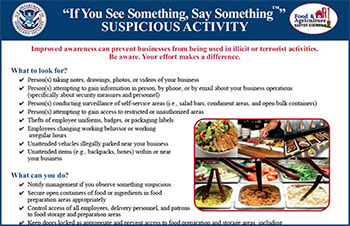Food Adulteration and Tampering
Food adulteration, whether motivated by economic fraud or malicious food tampering, can have serious effects on health and safety. Today, people are more aware than ever of the risks of food adulteration, and updated regulations reflect the need to have more protection at the government and industry level. For instance the Food Safety Modernization Act in the US mandates that food safety plans contain strategies to lessen the risk of food adulteration, with businesses held liable should adulterated products be released into commerce. When a substance is termed an ‘adulterant’, stronger penalties apply, including the possibility of criminal liability.
There are a huge number of possible substances that may be used for food adulteration, and the list continues to expand. Adulterants are often selected based on their ability to increase the apparent value of a product, their ability to be substituted for a more expensive ingredient or product, ability to mask certain substances or their risk (for instance, certain strains of naturally-occurring E. coli are deemed adulterants under food law, making it illegal to sell products containing these organisms).
In the laboratory setting, unknown adulterants are treated somewhat like mystery samples. Sometimes the answer is simple, however the nature of food adulteration is that the substance may be new or novel, and as a result the analysis is not designed to detect it.
Routine forensic testing is more applicable when the source of the contaminant is known or at least suspected, such as a piece of foreign material that can be compared with packaging or other suspected sources. Using a variety of methods, food scientists can look for thousands of known chemical, biological or physical contaminants (e.g. pesticides, heavy metals or antibiotics), while novel chemical substances (such as melamine) used in food adulteration will not show up in routine tests.
In the case of a “mystery adulterant”, investigators can often draw clues from details of the food supply chain or production process, interviews with personnel, a review of the symptoms in those affected by illness, or in some cases the development of novel test methods that can detect and identify the mystery substance.
However when food tampering occurs and you have no idea what you are specifically looking for, forensic testing can become expensive. Food adulteration can pass safety and quality tests because test methods can only be engineered to screen for so many things at once, and of the thousands of possible substances used in food adulteration, they may only be designed to pick up three or four. Multiple tests may be necessary to identify what the adulterant is, or even the development and validation of a completely new test (which can take days, weeks or even months and be extremely costly). Newer tests are geared to be more efficient in screening for multiple contaminants at once, but it is not currently feasible to test for food adulteration in a routine, large-scale manner across industry and government.
At present, food adulteration testing is being used strategically to detect the riskiest known and potential contaminants when food tampering is suspected. Newer tests are being designed that can screen for food adulteration more efficiently or confirm authenticity through genetic or biological markers. In order to protect against food adulteration, it is imperative that testing technologies are combined with government and industry intelligence, supplier certification, physical inspection of records and facilities and the assessment of product portfolio risks (e.g. identification of ‘value’ ingredients that would provide an incentive for substitutions or food adulteration).
To have more articles like this emailed to your inbox, become a GFSR Member today!

-
 FeaturedRisk management
The Cost of a Breach: What a Cyberattack Could Mean for Food Safety Recalls
FeaturedRisk management
The Cost of a Breach: What a Cyberattack Could Mean for Food Safety Recalls
-
 FeaturedRisk management
Securing the Food Chain: How ISO/IEC 27001 Strengthens Cybersecurity
FeaturedRisk management
Securing the Food Chain: How ISO/IEC 27001 Strengthens Cybersecurity
-
 FeaturedRisk management
Revolutionizing Food Safety Training: Breaking Out of the “Check-the-Box” Mentality
FeaturedRisk management
Revolutionizing Food Safety Training: Breaking Out of the “Check-the-Box” Mentality
-
 GFSI Standards
GFSI 2025: Building Trust, Tech-Forward Solutions, and Global Unity in Food Safety
GFSI Standards
GFSI 2025: Building Trust, Tech-Forward Solutions, and Global Unity in Food Safety
-
 FeaturedFood Safety
Integrated Pest Management: Strategies to Protect Your Brand’s Reputation
FeaturedFood Safety
Integrated Pest Management: Strategies to Protect Your Brand’s Reputation
-
 FeaturedFood Safety Culture & Training
No Open Door Policy: Challenges That Impact Pest Control in Food Processing Plants
FeaturedFood Safety Culture & Training
No Open Door Policy: Challenges That Impact Pest Control in Food Processing Plants



